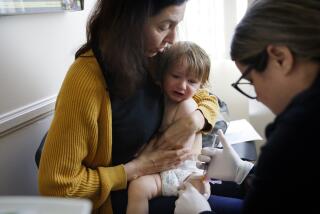Childhood Ear Infection Vaccines on Way
- Share via
If you’re the parent of a preschooler or of an elementary-age child, the results of a recent survey probably won’t surprise you.
Ear infections in children are the No. 1 health concern of these parents, according to a survey published recently in the journal Clinical Pediatrics. The poll included nearly 400 parents seeking medical care from pediatricians or pediatric clinics in California, Minnesota and Rhode Island.
Their worries are realistic. Two million children will have an ear infection before they taste their first birthday cake, according to the American Academy of Pediatrics. Government data shows that more than half of every 100 kids less than 5 years old have ear infections in a given year; about 11 of every 100 kids age 5 to 17 do. Children in day care are more susceptible. Recurrent ear infections, especially if untreated, can impair hearing and hinder language development.
Despite this gloom and doom, there are some bright spots.
Vaccines for childhood ear infections are being developed. Within a decade, perhaps sooner, prevention could negate the need for treatment. Children would get a dose of ear infection vaccine--much like they are immunized for measles and mumps.
At the University of Minnesota, doctors are testing infants and young children with a vaccine that targets Streptococcus pneumoniae, a common bacterial culprit in childhood ear infections. There is already a vaccine against this germ, but experts say it is effective only in adults.
Other researchers, including Dr. Anthony Magit at Childrens’ Hospital of Pittsburgh, are developing a second vaccine to target Haemophilus influenzae, another bacteria associated with childhood ear infections.
When perfected, the vaccines “probably will be given as a primary shot at age 3 to 6 months,” Magit speculates, “followed by a couple of boosters.” The ear infection vaccines might first be used in children under age 2, those at highest risk for ear infections, and then on a more widespread basis, Magit says.
Until the new vaccines are de rigueur , there are other steps parents can take.
* Breast-feeding during the first four months or longer might minimize ear infections, a recent University of Arizona study found.
Researchers tracked 1,216 infants treated for ear infections. About 20% of babies not breast-fed or breast-fed for less than four months had a recurrence, but only 12% of those breast-fed for at least four months had a recurrence.
* Getting medical attention early can also help. The common clues of ear infection, according to the American Academy of Pediatrics, are fever, pulling at the ear, excess fussiness, decreased appetite and decreased hearing. Children able to talk might complain of ear pain.
“But there are multiple presentations,” says Dr. William Luxford, an ear specialist at the House Ear Clinic in Los Angeles. Pulling at the ear, for instance, isn’t always a sure warning of an ear infection, he says. It could accompany teething, too. And, he notes, symptoms can vary from one child to another and from one infection to the next.
Ear infections usually occur because of a malfunctioning of the Eustachian tube, the small canal connecting the middle ear to the back of the throat. The tube, when working correctly, keeps the space behind the eardrum clear of fluid. When the tube doesn’t work properly, fluid sometimes gathers behind the eardrum, and bacteria can grow.
Sometimes fluid accumulates without resulting infection, Luxford says. But fluid, with or without infection, can impair eardrum functioning and temporary hearing loss can occur.
A short course of antibiotics is the usual treatment for infection, but parents often worry that repeated antibiotics might cause a child to build a tolerance. However, most experts say there is little basis for that worry.
If an antibiotic is not working, it could be that the bacteria have changed in midstream. Recurrent infections might respond best to what Luxford calls “low-dose, long-term” administration of antibiotics.
If fluid accumulation persists, your doctor might recommend as a last resort the surgical placement of tiny drainage tubes through the eardrum.
Brochures on “Earache and Otitis Media” and “Is My Baby’s Hearing Normal?” are available free from the American Academy of Otolaryngology, 1 Prince St., Alexandria, Va. 22314. Enclose a self-addressed stamped envelope.






